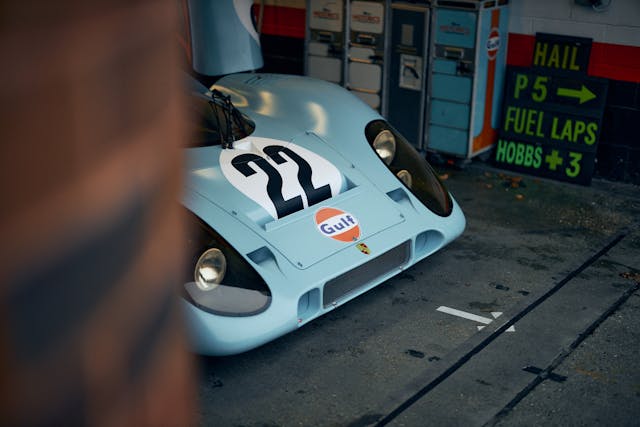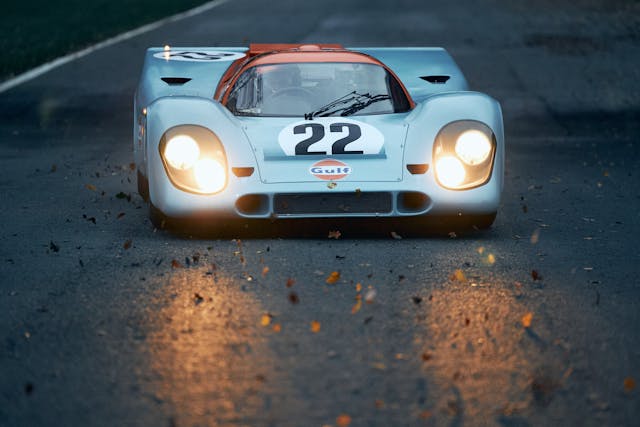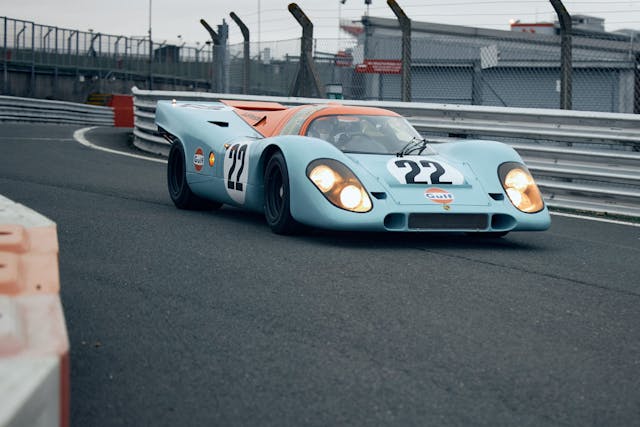This 1970 Porsche 917K, a Le Mans veteran, could sell for $18M at Monterey 2021
Monterey Car Week is still a few months away, but the possible star of this year’s auctions has already been announced. On August 13–14 at the Monterey Conference Center, a genuine Gulf-Porsche 917K that raced at Le Mans in 1970 with John Wyer’s legendary Gulf Oil team will come under the hammer.
It has the potential to be the most expensive Porsche ever sold at auction and is the first eight-figure consignment we’ve seen so far this year. RM’s presale estimate is $16M – $18.5M.
It’s hard to overstate the importance of the 917, both to the company that built it and to racing in general. It delivered Porsche the first of its 19 overall wins (so far) at the 24 Hours of Le Mans. It launched the company into a period of international sports car racing dominance that lasted through much of the 1970s and 1980s. It played a starring role in Steve McQueen’s 1971 film about the 24-hour classic, Le Mans. Then, the 917’s turbocharged variants (aka the “Turbo Panzers”) so thoroughly steamrolled the competition in Can-Am racing that they effectively ended the series. The 917 is also one of the cars that made both the Gulf and Martini color schemes among the most beloved color liveries in motorsport.

Since its earliest days Porsche had been a force to be reckoned with on track, but the Porsche racers of the 1950s and ’60s mostly duked it out in the smaller-displacement classes, occasionally punching above their weight for overall wins at tighter circuits. The 917 changed that. Taking advantage of a rule that allowed 5.0-liter cars to race so long as the manufacturer could screw together 25 complete examples, Porsche designed the 917 for 1969 with the goal of winning Le Mans overall. A spaceframe chassis, 4.5-liter air-cooled flat-12, and longtail bodywork were the early cars’ distinguishing features.
The 1969 Le Mans race was a bad one for the Porsche team, as none of the 917s entered were able to finish. The team’s 908 coupe finished second, but it wasn’t much consolation. It lost by just 120 meters to John Wyer’s Gulf-sponsored Ford GT40, which won for the second time in a row even though the GT40 was supposed to be an obsolete car.
Seeing that John Wyer’s Gulf team was such a slick operation and looking to reduce costs, Porsche sought out Wyer to race the 917 in the World Championship of Makes for 1970 and 1971. When asked in a meeting with the Porsche bosses how many cars he would need to win the championship, Wyer replied that two or three should get the job done. After a long silence, Ferry Porsche revealed that they had built 52 cars to win the championship the year before.
The agreement between Wyer and Porsche called for the Gulf team to get seven cars on loan with all future parts and engine rebuilds free, and although 917s would be sold to other teams, Wyer would get newly developed parts first. In the meantime, the 917’s main problem of poor high-speed stability had been solved with short tail (or “kurzheck”) bodywork, resulting in the 917K.

The 1970 season started extremely well for the Gulf team, with wins at the 24 Hours of Daytona, Brands Hatch, Monza, the Targa Florio, and Spa. For Le Mans, the team fielded three 917s. Jo Siffert and Brian Redman were in the lead car, Pedro Rodriguez and Leo Kinnunen piloted the second, and Brits David Hobbs and Mike Hailwood piloted the third. The Hobbs/Hailwood car, Chassis 917-031/026, is the car on offer in Monterey. Compared to the other two cars, it featured a 4.5- rather than 5.0-liter engine and wore a paint scheme with solid orange down to the beltline with blue below, rather than the orange stripe seen on the others.
Up against the blue and orange Gulf cars were 917s with both short and longtail bodywork (entered by the Austrian Porsche Salzburg team, the Martini team, and British privateer David Piper) as well as the new Ferrari 512Ss and Lola-Chevrolet T70 coupes. This was also the year Hollywood came to Le Mans, as footage from the race (including shots of the Hobbs/Hailwood car) was used in the epic 1971 racing film starring McQueen.
Ferry Porsche served as guest starter for the race in celebration of Porsche’s 20th year competing at Le Mans, and this would be the first year without the traditional “Le Mans start.” Instead of running across the track and jumping into their cars for the start, the drivers set off safely strapped in the cockpit.

From late afternoon until the next morning the track was battered by rain. Crashes followed, including one that took out most of Ferrari’s top contenders. After running as high as third place, Mike Hailwood, driving 917-031/026, aquaplaned on the 50th lap and crashed into a stopped Alfa Romeo. The other two Gulf cars retired with mechanical failures, leaving the 4.5-liter Porsche Salzburg 917K piloted by Hans Hermann and Dickie Attwood to take the checkered flag. Just 16 cars were running at the finish of Le Mans in 1970. Twelve of them were Porsches, and Porsches won all four classes as well as the Index of Performance and the Index of Thermal Efficiency. The 917 would win Le Mans once more in 1971 before the big 5.0-liter sports cars were banned for 1972.
Following Le Mans, the Hobbs/Hailwood 917K was repaired at the factory, then rebodied as a Spyder with lightweight red and yellow bodywork for InterSerie Group 7 racing—essentially the European equivalent of Can-Am at the time. Privateer Ernst Kraus raced it in the series for the 1971–72 seasons, then sold it to Georg Loos who campaigned it under his Gelo Racing Team banner in the 1973 season. From 1974–88, it was in the collection of racer and heir to the Moët et Chandon champagne fortune Olivier Chandon.
The car’s consignor for Monterey bought the 917, still in Spyder form, over a decade ago. It has since been restored to its original 1970 Le Mans specs, and that makes it a much more desirable car today. “The Gulf Oil Porsche 917K is essentially the holy grail of competition cars,” says RM’s Global Head of Auctions Gord Duff. And that it raced with one of the sport’s most famous teams ever and enjoyed screen time in one of the best racing movies ever made should afford it a record price in Monterey.”
Gooding & Company sold another 917K, one used as a Le Mans test car and then as a camera car for the movie, for $14,080,000 in Monterey four years ago. That’s the current high point for Porsches at auction, and that car had no actual race history. 917-031/026 one does, and when it roars up onto the auction block this August we’ll see just how much of a difference that will make.


